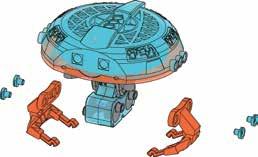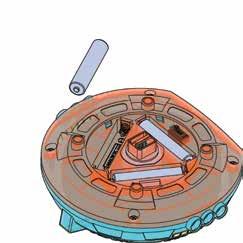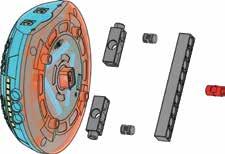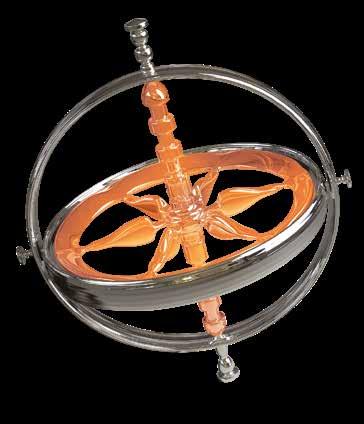
5 minute read
Physics Experiments
Balancing act
You will need
Advertisement
– Gyrobot’s head (carefully removed from the body)
Here’s how
1. Turn on the gyroscope using the switch shown on page 12 and wait for it to get up to its top speed.
2. Place the gyrobot’s head on the middle or index finger of one of your hands and hold it with your other hand. Make sure you hold the head low over a table or soft surface, like a sofa, so that nothing can happen if your attempt to balance it doesn’t work right away.
3. Align the head parallel to the surface below it. Check that your fingers are centered under the head and carefully let go of it with your other hand.
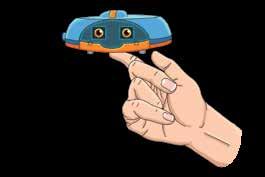
4. Now you can have the head balanced on one or two fingers. Hold your other hand close to stabilize the head if necessary.
5. Try this: When the head is well balanced on your finger, place the index finger of your other hand on the head and your thumb below. Try to change the position of the head slightly.
Do you feel the gyroscopic forces? Let’s examine the gyroscope more closely!
2
4
WhAt’s happeniNg?
In this experiment, you can experience the gyroscopic effect firsthand. This effect occurs when a wheel turns very quickly. This creates a force that tries to maintain the axis of rotation of the wheel. In other words, the force prevents the wheel from tilting out of the plane in which it is already spinning. As long as a gyroscope is rotating, it always maintains the original position of its axis of rotation.
Therefore, you probably observed the following: If the gyrobot’s head tilts, the gyroscopic effect pushes it back so that the axis of rotation is maintained. This is how the head balances on your finger, and how the body balances on the rope.
Trying to change the position of the head a bit with your other hand is not that easy, is it? You feel resistance. This is the force of the gyroscopic effect that fights against the change in position. The gyroscope’s axis of rotation tries to hold its position.
On edge
You will need
– Gyrobot’s head
Here’s how
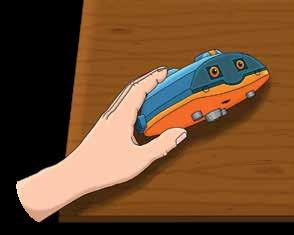
1. Place the gyrobot’s head on a flat surface with its eyes facing up toward the ceiling and the edge of the back of its head resting on the surface. Do not put the head completely upright, but tilt it slightly to the side. Do not turn the gyroscope on yet.
2. Let go carefully. What happens?
3. Now turn on the gyroscope inside the head and wait for it to get up to its top speed.
4. Now position the head on the surface as in step 1. Hold it in place for a little while and then gently let go. What happens?
1

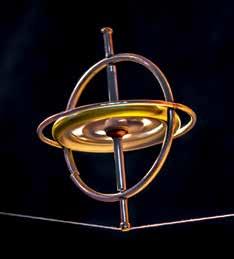
WhAt’s happeniNg?
With the gyroscope turned off, the gyrobot’s head falls over. The reason for this is gravity, which is a force that pulls all bodies and objects on Earth toward the center of the Earth. It is thus also referred to as gravitational pull. This arises from the fact that the Earth is much heavier than all the bodies on it. The more massive an object, the stronger its pull on other objects. Due to gravity, things on Earth always fall toward the surface of the Earth and do not “fall” away from the Earth.
With the gyroscope turned on, the head no longer falls over. It turns slowly in its slightly tilted position. Again, it is the gyroscope’s gyro effect that makes the head balance on its edge like this. The gyroscopic effect even holds
the entire gyrobot in position against the
force of gravity! If the head begins to tilt due to gravity, the gyroscopic effect directs it back to its axis of rotation.
Spinning top
You will need
– Gyrobot’s head – 3 x 3-hole dual rods – 9-hole rod – Red anchor pin
Here’s how Tips
For this experiment, you will need to disassemble the tightrope frame to get some of these parts.
1. Assemble the four rods and the red anchor pin as shown in Figure 1. Then attach the gyrobot’s head to the assembly as shown.
2. On a tabletop, balance the assembly on the tip of its bottom rod. With the gyroscope switched off, gently push the head from the side with your finger or a pen. What happens to the whole assembly?
3. Repeat the experiment with the gyroscope switched on. Wait for the gyroscope to get up to its top speed and then gently push the head from the side (which is perpendicular to its axis of rotation).
What do you observe?
1
2
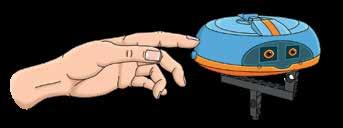
WhAt’s happeniNg?
With the gyroscope turned off, the gyroscope assembly falls over when pushed. When the gyroscope is switched on, the results are different. When pushed, the assembly turns on the tip of the rod and remains in balance. The gyroscopic effect keeps the gyroscope in its axis of rotation. This is how toy spinning tops work too: Only when a top is spinning does it balance on its tip.
However, external forces (such as you when you push on the head, and also the force of friction between the tip of the rod and the tabletop) can affect the gyroscopic effect. The gyroscope reacts by swerving a little. You can see this firsthand: The model does not turn evenly around the axis of rotation, but wobbles a little. The gyroscope changes its axis of rotation when exposed to external forces. This deviation of the axis of rotation is not arbitrary: The axis of rotation always deviates on a constant circular path. The axis of rotation turns around another invisible axis. This process is called precession.


